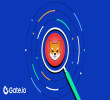7 November 2025
The New Content Wave Through Web3 and NFTs
As everyone knows, Web3 is the next iteration of the internet, and it will allow users to break free of the monopoly of a few large technology firms. One of the most important factors in determining a piece of content or an artwork's reach is Web3, a decentralized system produced, maintained, and controlled by various stakeholders. Due to the algorithmic nature of search engines, we may safely assume that the corporation keeps a close eye on and controls the many filters that the information must pass through before it reaches the intended population. The goal of Web3 is to provide a platform where consumers and artists may work together in virtual space without having to worry about being controlled by centralized data stores.
Also Read: 10 Best NFT Fractionalization Projects Of 2023
What is Web3?
The notion of Web3 or also known as Web 3.0, is for a next generation of the Web that includes features like decentralization, blockchain technology, as well as coin-based economy. In contrast to Web 2.0, which some engineers and journalists have said concentrates data and content in the hands of a few large corporations or dubbed "Big Tech", Web 1.0 was developed with the goal of distributing its features and functions more widely. Gavin Wood, co-founder of Ethereum, first used the phrase "Web3" in 2014. By 2021, the concept had caught the attention of Cryptocurrency fans, major technological corporations, as well as VCs. Critics say that Web3 would help consumers protect their content, make their systems more scalable, and keep their personal information private, all while countering the might of giant tech firms.
Also Read: Fraud Charged Against Mutant Ape Planet NFT Collection Developer
What are NFTs?
Non-Fungible Tokens (NFTs) are virtual tokens which are stored on a blockchain as well as are utilized to verify possession and validity without being duplicated, swapped, or split. Because of the immutability of the blockchain, NFTs may be sold and exchanged freely between buyers and sellers. NFTs are easy to make and don't need any knowledge of programming. Images, movies, and audio are only some of the common types of digital media that may be referenced in NFTs. NFTs are distinct from fungible Cryptocurrencies in that each NFT is a single asset. However, the legitimate powers transferred by an NFT are not always clear, despite claims to the contrary by developers of NFTs.
The Money Machines - Web3 & NFTs
The marketplace for Web3 virtual goods is expanding rapidly, despite the fact that Web3 and NFTs as technology are still in their infancy. People, especially content creators, find it hard to say no to the opportunities it presents. A sizable number of producers have made names for themselves on more traditional virtual mediums, although they are unusual on Web3 as well as NFTs. With more than 50 million innovators, the market is primed for new ideas. With its 37 million creators, YouTube pays out approximately $15 billion to entertainers annually, or $636 each creator.
In addition, to even make a respectable living, you'll need to put in a lot of effort to gather viewers by making hundreds of videos. There are extra obligations, such as the need to sell items, negotiate branded agreements, form paid collaborations, and go on paid tours. NFTs only include 22,400 artists at the moment, but they bring in $4 billion annually. However, after the creator understands the process of making NFTs, the rest is up to the audience.
The Pinnacle of Hope - NFTs
Forget the rumors and fears that surround the NFT market as a digital artistic portal with potential danger for participants; the opportunities it presents to artists and enterprises are boundless. Users may not only make new NFTs, but can also repurpose existing media. Blockchain technology is resistant to the censoring practices of the large IT companies. If the Non-Fungible Token is deemed valuable by the public, it will be included on the system. Blockchain allows for the background voting down of content without the content being deleted entirely. Only if it receives enough negative votes will it be removed, which is far preferable than censoring. There is no third party involved in the voting procedure; instead, the writer's friends as well as acquaintances cast their ballots.
Purchasers send Cryptocurrency to the seller's wallet in exchange for the content or a portion of it. What this means is that the creator gives up some control to the people who like their work. However, the copyright difficulties will be put on hold since only the author will be acknowledged as the original inventor. That's not the last chapter. Now that authors may issue their own Cryptocurrency, readers can financially support their favorite writers. To clarify, DeSo, that is exactly what an NFT platform would accomplish. Accounts on social networking sites may be suspended at any time, thereby erasing the writer's work from the web forever. In addition, writers really have to convince their fans to part over their email addresses so they may contact their public. In web3, however, because writers are linked straight to readers, the profile is less likely to be shuttered without a fight.
Disclaimer: The author’s thoughts and comments are solely for educational reasons and informative purposes only. They do not represent financial, investment, or other advice.






